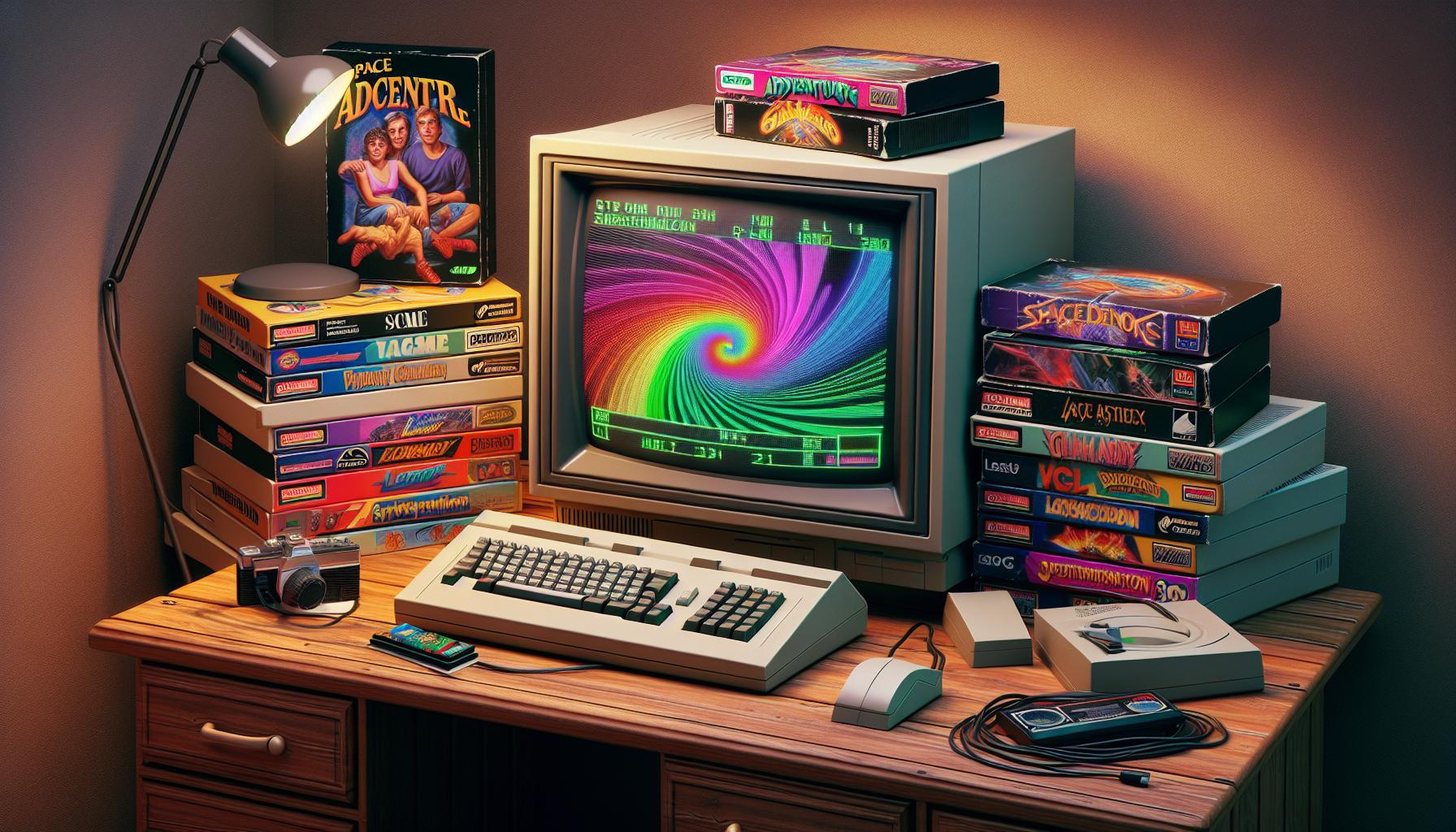As someone who’s witnessed when did Pc Gaming become popular? firsthand I can tell you that PC gaming’s rise to popularity is a fascinating journey through technological advancement. While gaming consoles dominated living rooms in the 1980s PC gaming was quietly building its foundation in homes and offices around the world.
I’ve seen the transformation from simple text-based adventures to today’s photorealistic masterpieces. The real turning point for PC gaming came in the early 1990s when powerful graphics cards and processors made immersive 3D gaming possible. Games like Doom and Wolfenstein 3D revolutionized the industry and showed everyone what PCs could really do. Today PC gaming has evolved into a $37 billion industry with millions of players worldwide connecting through platforms like Steam and Epic Games.
- PC gaming gained significant popularity in the early 1990s with the introduction of advanced graphics cards and 3D gaming capabilities
- The industry evolved from simple text-based games in the 1970s to a $37 billion global market today with millions of players
- Major technological breakthroughs like VGA graphics (1991) and 3dfx Voodoo graphics card (1996) revolutionized gaming visuals and experiences
- Digital distribution platforms like Steam (2003) transformed game accessibility and sales, now accounting for 80% of PC game purchases
- The rise of esports and competitive gaming since 2011 has further boosted PC gaming’s popularity, with tournaments offering multi-million dollar prizes
- Independent game development has flourished through digital platforms, producing massive hits like Stardew Valley and Among Us
When Did Pc Gaming Become Popular
The 1970s marked the foundational era of when did Pc Gaming become popular, transitioning from mainframe computers to personal computing devices. Computer enthusiasts created primitive yet groundbreaking games that established core gaming mechanics.
The Birth of Text-Based Games
Text-based adventures emerged in 1975 with the release of Adventure (Colossal Cave), created by Will Crowther at BBN Technologies. These games displayed text descriptions of environments locations on monochrome screens requiring players to type commands like “go north” or “get sword.” Notable titles included:
- Hunt the Wumpus (1973) featuring basic monster-hunting gameplay
- Zork (1977) introducing complex storytelling mechanics
- Star Trek (1971) establishing strategic combat elements
- Oregon Trail (1971) combining education with entertainment
Arrival of the First Home Computers
Home computers transformed gaming accessibility in 1977 with the release of the Trinity: the Apple II TRS-80 Commodore PET. Each system offered distinct gaming capabilities:
| Computer Model | Release Year | Price (USD) | Notable Games |
|---|---|---|---|
| Apple II | 1977 | $1,298 | Lemonade Stand Mystery House |
| TRS-80 | 1977 | $599 | Dancing Demon Haunted House |
| Commodore PET | 1977 | $795 | Lunar Lander Microchess |
- 4-16KB RAM capacity
- Cassette tape storage systems
- Basic graphics capabilities
- Built-in BASIC programming language
The Golden Era of the 1980s


The 1980s marked a transformative period when did Pc Gaming become popular, characterized by technological advancements and the introduction of color graphics. The IBM PC’s release in 1981 established a standardized platform for game development, creating new opportunities for both developers and players.
Rise of IBM PC Gaming
IBM PC gaming gained momentum in 1981 with Microsoft’s release of Flight Simulator when did Pc Gaming become popular, selling over 800,000 copies. The introduction of CGA graphics cards enabled 4-color displays, leading to visually enhanced games like King’s Quest (1984) and Space Quest (1986). The standardization of PC hardware specifications simplified game development, resulting in 375 PC games released between 1982-1985.
| Year | Milestone | Impact |
|---|---|---|
| 1981 | IBM PC Launch | Standardized gaming platform |
| 1982 | CGA Graphics | 4-color gaming visuals |
| 1984 | EGA Graphics | 16-color display support |
| 1987 | VGA Graphics | 256-color capabilities |
Emergence of Major Game Publishers
The 1980s witnessed the rise of influential game publishers:
- Sierra On-Line revolutionized adventure gaming with graphic-based titles
- Electronic Arts launched in 1982, introducing popular franchises like Pinball Construction Set
- Broderbund Software dominated the market with titles like Karateka and Prince of Persia
- MicroProse specialized in simulation games, releasing classics like F-19 Stealth Fighter
- 1982: First third-party game publishers emerge
- 1984: Distribution networks establish nationwide reach
- 1987: Publishers adopt standardized packaging formats
- 1989: Major publishers achieve $100M+ annual revenues
The Revolutionary 1990s Gaming Boom


The 1990s marked an unprecedented expansion when did Pc Gaming become popular, driven by technological breakthroughs in graphics, processing power, and connectivity. Computer gaming transformed from a niche hobby into mainstream entertainment during this pivotal decade.
Introduction of VGA Graphics
VGA graphics cards revolutionized PC gaming in 1991 by enabling 256-color displays at 320×200 resolution. Games like Wing Commander II and Ultima VII showcased vibrant visuals with 256 simultaneous colors on screen, compared to the previous 16-color limitation. The Super VGA standard in 1993 pushed resolutions to 800×600, enabling games like Myst to deliver photorealistic environments that attracted 6 million players.
The Rise of 3D Gaming
3D acceleration cards transformed gaming in 1996 with the release of the 3dfx Voodoo graphics card. Notable titles included:
- Quake utilized full 3D environments with real-time lighting effects
- Tomb Raider introduced 3D character models with 2,000 polygons
- Half-Life combined narrative storytelling with advanced physics in 1998
- Unreal showcased dynamic lighting effects across detailed environments
- Doom popularized multiplayer gaming through LAN parties in 1993
- Battle.net launched in 1996 supporting 50,000 concurrent Diablo players
- QuakeWorld introduced client-side prediction for smoother online play
- Total Annihilation enabled 8-player battles across 5,000 unit matches
| Game Title | Release Year | Peak Players | Notable Achievement |
|---|---|---|---|
| Doom | 1993 | 20M copies | First mainstream deathmatch |
| Diablo | 1996 | 2.5M copies | First battle.net game |
| Quake | 1996 | 1.5M copies | True 3D engine pioneer |
| Half-Life | 1998 | 9.3M copies | Modding community success |
Key Factors That Drove PC Gaming’s Growth


PC gaming experienced exponential growth due to several interconnected technological advances when did Pc Gaming become popular. These developments transformed gaming from a niche hobby into a mainstream entertainment medium.
Hardware Advancements
Graphics processing innovations revolutionized PC gaming visuals between 1995-2005. The introduction of dedicated 3D graphics cards, like the NVIDIA GeForce 256 in 1999, enabled real-time 3D rendering at 60 frames per second. CPU improvements from Intel’s Pentium series delivered 10x performance increases, supporting complex game physics engines. Storage capacity expanded from 500MB hard drives to 250GB drives, allowing for larger game installations with detailed textures animations.
| Hardware Component | 1995 Specs | 2005 Specs | Performance Increase |
|---|---|---|---|
| Graphics Memory | 2MB | 256MB | 128x |
| CPU Speed | 100MHz | 3.8GHz | 38x |
| RAM | 8MB | 2GB | 256x |
| Storage | 500MB | 250GB | 500x |
Digital Distribution Platforms
Digital distribution transformed game accessibility starting in 2003 with Steam’s launch. These platforms eliminated physical media requirements delivering instant game access through downloads. Key developments include:
- Steam’s introduction of auto-updates patching games automatically
- Direct2Drive launching in 2004 focusing on DRM-free gaming
- GOG.com’s 2008 debut preserving classic PC games
- Origin’s 2011 release providing EA’s gaming catalog
- Epic Games Store’s 2018 entry offering revenue-sharing benefits
Platform competition led to frequent sales events reducing game prices by 50-90%. Digital distribution platforms now process over 80% of PC game sales generating $37.4 billion in 2020 revenue.
Modern PC Gaming Culture
PC gaming culture thrives through interconnected communities spanning competitive esports competitive gaming indie development. The global PC gaming community generates over $37 billion in annual revenue with more than 1.5 billion active players worldwide.
eSports and Competitive Gaming
Professional gaming emerged as a cultural phenomenon with the launch of major tournaments in 2011. The International Dota 2 Championship offers prize pools exceeding $40 million while League of Legends World Championship draws over 100 million viewers. Popular esports titles include:
- Counter-Strike: Global Offensive hosting 24 major tournaments annually
- Valorant featuring 3 international leagues with 30 partnered teams
- Dota 2 maintaining a year-round competitive circuit across 6 regions
- League of Legends operating 12 professional regional leagues globally
Indie Game Development
Independent game development experienced unprecedented growth through digital distribution platforms starting in 2008. Steam’s Early Access program launched in 2013 hosts over 6,000 indie titles generating $3.5 billion in revenue. Notable indie success stories include:
- Stardew Valley selling 20 million copies across platforms
- Among Us reaching 500 million active players in 2020
- Minecraft starting as an indie project before selling for $2.5 billion
- Undertale achieving cult status with 3.5 million sales
- Unity Engine powering 50% of mobile games
- Unreal Engine offering free licensing for revenues under $1 million
- GameMaker Studio supporting 2D game development for beginners
- Godot providing open-source development options
The journey of PC gaming from its humble beginnings to today’s thriving industry is nothing short of remarkable. I’ve watched this transformation unfold from basic text adventures to photorealistic masterpieces that push technological boundaries.
With over 1.5 billion active players and a $37 billion market value when did Pc Gaming become popular has evolved into more than just entertainment – it’s become a cultural phenomenon. The combination of hardware innovations digital distribution platforms and a vibrant gaming community has created an ecosystem that continues to grow and innovate.
I’m confident that PC gaming will keep pushing boundaries as new technologies emerge. The platform’s ability to adapt and evolve while maintaining its core appeal to both casual and hardcore gamers ensures its place at the forefront of gaming culture.

